Grants and Funding for the Processes of Decarbonization in the Scope of Sustainability Development—The Case from Poland
Abstract
1. Introduction
2. Background
3. Literature Review
4. Materials and Methods
- Survey research (online survey).
- Intentional sample selection, using the “snowball” method.
- The Kruskal–Wallis H Test, the Mann–Whitney U Test, and the Pearson chi-square independence test.
5. Results
- Energy compensation, energy storage, production by day, and reception at night.
- Support for the development of highly efficient, modern energy sources (e.g., cogeneration bonus, RES).
6. Conclusions
Author Contributions
Funding
Institutional Review Board Statement
Informed Consent Statement
Data Availability Statement
Acknowledgments
Conflicts of Interest
References
- National Planning Commission. National Review of Sustainable Development Goals; Report 2020; National Planning Commission: Kathmandu, Nepal, 2020.
- Fonseca, L.M.; Domingues, J.P.; Dima, A.M. Mapping the Sustainable Development Goals Relationships. Sustainability 2020, 12, 3359. [Google Scholar] [CrossRef]
- UNFCC COP26 Explained; 2021. Available online: https://ukcop26.org/cop26-goals/ (accessed on 24 February 2022).
- Masood, E.; Tollefson, J. COP26 climate pledges: What scientists think so far. Nature 2021. [Google Scholar] [CrossRef] [PubMed]
- Al-Gasawneh, J.A.; Anuar, M.M.; Dacko-Pikiewicz, Z.; Saputra, J. The impact of customer relationship management dimensions on service quality. Pol. J. Manag. Stud. 2021, 23, 24–41. [Google Scholar] [CrossRef]
- Hussain, H.; Haseeb, M.; Kamarudin, F.; Dacko-Pikiewicz, Z.; Szczepańska-Woszczyna, K. The Role of Globalization, Economic Growth and Natural Resources on the Ecological Footprint in Thailand: Evidence from Nonlinear Causal Estimations. Processes 2021, 9, 1103. [Google Scholar] [CrossRef]
- Meekaewkunchorn, N.; Szczepańska-Woszczyna, K.; Muangmee, C.; Kassakorn, N.; Khalid, B. Entrepreneurial orientation and SME performance: The mediating role of learning orientation. Econ. Sociol. 2021, 14, 294–312. [Google Scholar] [CrossRef]
- Gorynia, M. Will COVID-19 Kill Globalization? In COVID-19 and International Business; Routledge: New York, NY, USA, 2021; ISBN 9781003108924. [Google Scholar] [CrossRef]
- Siksnelyte-Butkiene, I. Impact of the COVID-19 Pandemic to the Sustainability of the Energy Sector. Sustainability 2021, 13, 12973. [Google Scholar] [CrossRef]
- Dyduch, W.; Chudziński, P.; Cyfert, S.; Zastempowski, M. Dynamic capabilities, value creation and value capture: Evidence from SMEs under Covid-19 lockdown in Poland. PLoS ONE 2021, 16, e0252423. [Google Scholar] [CrossRef]
- Malec, M.; Kinelski, G.; Czarnecka, M. The Impact of COVID-19 on Electricity Demand Profiles: A Case Study of Selected Business Clients in Poland. Energies 2021, 14, 5332. [Google Scholar] [CrossRef]
- Rzepka, P.; Sołtysik, M.; Szablicki, M. Prosumencka Chmura energii—Koncepcja Nowej Usługi Dla Prosumentów; Zeszyty Naukowe PAN: Kraków, Poland, 2017; pp. 177–186. [Google Scholar]
- Botelho, D.; de Oliveira, L.; Dias, B.; Soares, T.; Moraes, C. Prosumer integration into the Brazilian energy sector: An overview of innovative business models and regulatory challenges. Energy Policy 2021, 161, 112735. [Google Scholar] [CrossRef]
- Sołtysik, M.; Kozakiewicz, M.; Jasiński, J. Profitability of Prosumers According to Various Business Models—An Analysis in the Light of the COVID-19 Effect. Energies 2021, 14, 8488. [Google Scholar] [CrossRef]
- Cygańska, M.; Kludacz-Alessandri, M. Determinants of Electrical and Thermal Energy Consumption in Hospitals According to Climate Zones in Poland. Energies 2021, 14, 7585. [Google Scholar] [CrossRef]
- Czarnecka, M. Sposoby Zawierania Umów z Konsumentami w Prawie Energetycznym od dnia jego Powstania do dnia Dzisiejszego; Prace Naukowe Wydawnictwo Uniwersytetu Ekonomicznego we Wrocławiu: Wrocław, Poland, 2014. [Google Scholar] [CrossRef]
- Kludacz-Alessandri, M.; Cygańska, M. Corporate Social Responsibility and Financial Performance among Energy Sector Companies. Energies 2021, 14, 6068. [Google Scholar] [CrossRef]
- Bałdowski, M.; Będkowski-Kozioł, M.; Bruszewski, M.; Grzejdziak, Ł.; Hawranek, P.; Jankowski, Ł.; Karpiński, M.; Kinelski, G.; Kosiński, E.; Kowalczyk, J. Prawo Energetyczne. Ustawa o Odnawialnych Źródłach Energii. Ustawa o Rynku Mocy. Ustawa o Inwestycjach w Zakresie Elektrowni Wiatrowych: Komentarz; Wydawnictwo C. H. Beck: Warszawa, Poland, 2020. [Google Scholar]
- Saługa, P.W.; Zamasz, K.; Dacko-Pikiewicz, Z.; Szczepańska-Woszczyna, K.; Malec, M. Risk-Adjusted Discount Rate and Its Components for Onshore Wind Farms at the Feasibility Stage. Energies 2021, 14, 6840. [Google Scholar] [CrossRef]
- Hübler, M.; Löschel, A. The EU Decarbonisation Roadmap 2050—What way to walk? Energy Policy 2013, 55, 190–207. [Google Scholar] [CrossRef]
- Wierzbowski, M.; Filipiak, I.; Lyzwa, W. Polish energy policy 2050—An instrument to develop a diversified and sustainable electricity generation mix in coal-based energy system. Renew. Sustain. Energy Rev. 2017, 74, 51–70. [Google Scholar] [CrossRef]
- Drożdż, W.; Mróz-Malik, O.J. Challenges for the Polish energy policy in the field of offshore wind energy development. Polityka Energetyczna–Energy Policy J. 2020, 23, 5–18. [Google Scholar] [CrossRef]
- Pilipczuk, O. Determinants of Managerial Competences Transformation in the Polish Energy Industry. Energies 2021, 14, 6788. [Google Scholar] [CrossRef]
- Kinelski, G. Marketing of an Energy Company-Selected Aspects from the Perspective of the Polish Market. Polityka Energetyczna–Energy Policy J. 2014, 17, 309–319. [Google Scholar]
- Åhman, M.; Nilsson, L.J.; Johansson, B. Global climate policy and deep decarbonization of energy-intensive industries. Clim. Policy 2016, 17, 634–649. [Google Scholar] [CrossRef]
- Zamasz, K. Energy company in a competitive energy market. Polityka Energetyczn–Energy Policy J. 2018, 21, 35–48. [Google Scholar] [CrossRef]
- Dariusz, M.; Paweł, H. Financing the Green Revolution through Power Purchase Agreements (PPAs). Internetowy Kwartalnik Antymonopolowy i Regulacyjny 2021, 2, 8–23. [Google Scholar]
- Bartkowiak, A.; Bartkowiak, P. The Determinants of Sustainable Development of Agriculture Sector in Poland. Transform. Bus. Econ. 2012, 11, 298–314. [Google Scholar]
- Bartkowiak, A.; Bartkowiak, P. Technical and Technological Progress in the Context of Sustainable Development of Agriculture in Poland. Procedia Eng. 2017, 182, 66–75. [Google Scholar] [CrossRef]
- Bartkowiak, P.; Rutkowski, I.P.; Bartkowiak, A. A model approach to the maturity and the level of risk in the product innovation process. Stud. Prace WNEiZ 2019, 55, 129–142. [Google Scholar] [CrossRef]
- Krzakiewicz, K.; Bartkowiak, P. Imitation as a Competitive Strategy. In Proceedings of the International Scientific Conference Hradec Economic Days 2021, Hradec Králové, Czech Republic, 13–14 April 2021; Volume 11. [Google Scholar]
- Bartkowiak, A.; Kuzminski, L.; Wojtaszek, H. Functioning of Retail Outlets in Poland during the COVID-19 Pandemic at Hours Accessible Only to Persons 65+: The Traders’ Perspective. Eur. Res. Stud. J. 2021, XXIV, 1081–1094. [Google Scholar] [CrossRef]
- Managi, S.; Broadstock, D.; Wurgler, J. Green and climate finance: Challenges and opportunities. Int. Rev. Financ. Anal. 2021, 79, 101962. [Google Scholar] [CrossRef]
- Leal-Arcas, R. Towards Sustainability in Trade, Energy and Climate. Mod. Environ. Sci. Eng. 2020, 6, 1–30. [Google Scholar] [CrossRef]
- Kupiec, B. Legal status of a renewables self-consumer under Polish law in light of Directive (EU) 2018/2001 of the European Parliament and of the Council of 11 December 2018 on the promotion of the use of energy from renewable sources. Stud. Prace Prawnicze Adm. Èkon. 2021, 35, 85–101. [Google Scholar] [CrossRef]
- Mucha-Kuś, K. Measurable Effects of Metropolitan Gas Purchasing Group in the Light of Gas Market Functioning in Poland. Resources 2020, 9, 36. [Google Scholar] [CrossRef]
- Czakon, W.; Mucha-Kuś, K.; Sołtysik, M. Coopetitive platform: Common benefits in electricity and gas distribution. Energies 2021, 14, 7113. [Google Scholar] [CrossRef]
- Graf, C.; Quaglia, F.; Wolak, F. Simplified Electricity Market Models with Significant Intermittent Renewable Capacity: Evidence from Italy; National Bureau of Economic Research, Inc.: Cambridge, MA, USA, 2020. [Google Scholar] [CrossRef]
- Koszel, M.; Bartkowiak, P. Taksonomiczna miara zrównoważonego rozwoju obszarów metropolitalnych w Polsce. Zesz. Nauk. Uniw. Èkon. w Krakowie 2018, 3, 83–100. [Google Scholar] [CrossRef]
- Bartkowiak, A. Metody i Instalacje Do Produkcji Energii Elektrycznej i Ciepła w Rafinerii Biomasy. In Produkcja Biogazu w Rafinerii Biomasy z Uwzględnieniem Aspektów Eksploatacji Biogazowi; UEP: Poznań, Poland, 2020. [Google Scholar]
- Kaczmarzewski, S.; Matuszewska, D.; Sołtysik, M. Analysis of Selected Service Industries in Terms of the Use of Photovoltaics before and during the COVID-19 Pandemic. Energies 2021, 15, 188. [Google Scholar] [CrossRef]
- Kaczmarzewski, S.; Olczak, P.; Sołtysik, M. The Impact of Electricity Consumption Profile in Underground Mines to Cooperate with RES. Energies 2021, 14, 5775. [Google Scholar] [CrossRef]
- Mucha-Kuś, K.; Sołtysik, M.; Zamasz, K. Rola Koopetycji W Klastrach Energiizeszyty; Naukowe Wydziału Elektrotechniki i Automatyki Politechniki Gdańskiej: Gdańsk, Poland, 2017. [Google Scholar]
- Wawrzyniak, K.; Padrón, E.U.; Gomulski, K.; Korab, R.; Jaworski, W. Methodology of risk assessment and decomposition in power grid applications. IET Gener. Transm. Distrib. 2018, 12, 3666–3672. [Google Scholar] [CrossRef]
- Gorynia, M. Competition and globalisation in economic sciences. Selected aspects. Econ. Bus. Rev. 2019, 5, 118–133. [Google Scholar] [CrossRef]
- Gorynia, M. Studia Nad Transformacją i Internacjonalizacją Gospodarki Polskiej; Difin: Warsaw, Poland, 2007; ISBN 9788372518200. [Google Scholar]
- Gorynia, M.; Howak, J.; Wolniak, R. Motives and modes of FDI in Poland: An exploratory qualitative study. J. East Eur. Manag. Stud. 2007, 12, 132–151. [Google Scholar] [CrossRef]
- Sun, Y.; Xue, J.; Shi, X.; Wang, K.; Qi, S.; Wang, L.; Wang, C. A dynamic and continuous allowances allocation methodology for the prevention of carbon leakage: Emission control coefficients. Appl. Energy 2018, 236, 220–230. [Google Scholar] [CrossRef]
- Tian, J.-F.; Pan, C.; Xue, R.; Yang, X.-T.; Wang, C.; Jin-Fang, T.; Shan, Y.-L. Corporate innovation and environmental investment: The moderating role of institutional environment. Adv. Clim. Change Res. 2020, 11, 85–91. [Google Scholar] [CrossRef]
- Wan, D.; Xue, R.; Linnenluecke, M.; Tian, J.; Shan, Y. The impact of investor attention during COVID-19 on investment in clean energy versus fossil fuel firms. Finance Res. Lett. 2021, 43, 101955. [Google Scholar] [CrossRef]
- Makieła, Z.J.; Kinelski, G.; Stęchły, J.; Raczek, M.; Wrana, K.; Michałek, J. Tools for Network Smart City Management—The Case Study of Potential Possibility of Managing Energy and Associated Emissions in Metropolitan Areas. Energies 2022, 15, 2316. [Google Scholar] [CrossRef]
- Makieła, Z.J.; Stuss, M.M.; Mucha-Kuś, K.; Kinelski, G.; Budziński, M.; Michałek, J. Smart City 4.0: Sustainable Urban Development in the Metropolis GZM. Sustainability 2022, 14, 3516. [Google Scholar] [CrossRef]
- He, J.-K. Global low-carbon transition and China’s response strategies. Adv. Clim. Change Res. 2016, 7, 204–212. [Google Scholar] [CrossRef]
- Nieto, J.; Carpintero, Ó.; Miguel, L.J.; de Blas, I. Macroeconomic modelling under energy constraints: Global low carbon transition scenarios. Energy Policy 2019, 137, 111090. [Google Scholar] [CrossRef]
- Kinelski, G.; Stęchły, J.; Bartkowiak, P. Various Facets of Sustainable Smart City Management: Selected Examples from Polish Metropolitan Areas. Energies 2022, 15, 2980. [Google Scholar] [CrossRef]
- Bartkowiak, A.; Bartkowiak, P.; Kinelski, G. Efficiency of Shaping the Value Chain in the Area of the Use of Raw Materials in Agro-Biorefinery in Sustainable Development. Energies 2022, 15, 6260. [Google Scholar] [CrossRef]
- Mucha-Kuś, K.; Sołtysik, M.; Zamasz, K.; Szczepańska-Woszczyna, K. Coopetitive Nature of Energy Communities—The Energy Transition Context. Energies 2021, 14, 931. [Google Scholar] [CrossRef]
- Jasiński, J.; Kozakiewicz, M.; Sołtysik, M. Determinants of Energy Cooperatives’ Development in Rural Areas—Evidence from Poland. Energies 2021, 14, 319. [Google Scholar] [CrossRef]
- Wójcik-Jurkiewicz, M.; Czarnecka, M.; Kinelski, G.; Sadowska, B.; Bilińska-Reformat, K. Determinants of Decarbonisation in the Transformation of the Energy Sector: The Case of Poland. Energies 2021, 14, 1217. [Google Scholar] [CrossRef]
- Czarnecka, M.; Kinelski, G.; Stefańska, M.; Grzesiak, M.; Budka, B. Social Media Engagement in Shaping Green Energy Business Models. Energies 2022, 15, 1727. [Google Scholar] [CrossRef]
- Kowalik; Prokop, B. Gospodarka Narodowa. Gospodarka Narodowa 2014, 3, 153–166. [Google Scholar]
- Singh, N.; Nyuur, R.; Richmond, B. Renewable Energy Development as a Driver of Economic Growth: Evidence from Multivariate Panel Data Analysis. Sustainability 2019, 11, 2418. [Google Scholar] [CrossRef]
- Jiang, K.J. 1.5 °C Target: Not a Hopeless Imagination. Adv. Clim. Change Res. 2018, 9, 93–94. [Google Scholar] [CrossRef]
- Papadis, E.; Tsatsaronis, G. Challenges in the decarbonization of the energy sector. Energy 2020, 205, 118025. [Google Scholar] [CrossRef]
- Smith, A.; Stirling, A. The Politics of Social-ecological Resilience and Sustainable Socio-technical Transitions. Ecol. Soc. 2010, 15, 11. [Google Scholar] [CrossRef]
- Fay, M.; Hallegatte, S.; Vogt-Schilb, A.; Rozenberg, J.; Narloch, U.; Kerr, T. Decarbonizing Development: Three Steps to a Zero-Carbon Future; Climate Change and Development; World Bank: Washington, DC, USA, 2015. [Google Scholar] [CrossRef]
- Skea, J.; Hourcade, J.C.; Lechtenböhmer, S. Climate Policies in a Changing World Context: Is a Paradigm Shift Needed? Climate Policy 2013, 13, 1–4. [Google Scholar] [CrossRef]
- Loftus, P.J.; Cohen, A.M.; Long, J.C.S.; Jenkins, J. A critical review of global decarbonization scenarios: What do they tell us about feasibility? WIREs Clim. Change 2014, 6, 93–112. [Google Scholar] [CrossRef]
- Sovacool, B.K.; Noel, L.; Axsen, J.; Kempton, W. The neglected social dimensions to a vehicle-to-grid (V2G) transition: A critical and systematic review. Environ. Res. Lett. 2017, 13, 013001. [Google Scholar] [CrossRef]
- Sovacool, B.K. What are we doing here? Analyzing fifteen years of energy scholarship and proposing a social science research agenda. Energy Res. Soc. Sci. 2014, 1, 1–29. [Google Scholar] [CrossRef]
- Sovacool, B.K.; Hirsh, R.F. Beyond batteries: An examination of the benefits and barriers to plug-in hybrid electric vehicles (PHEVs) and a vehicle-to-grid (V2G) transition. Energy Policy 2009, 37, 1095–1103. [Google Scholar] [CrossRef]
- Sovacool, B.K.; Axsen, J.; Sorrell, S. Promoting novelty, rigor, and style in energy social science: Towards codes of practice for appropriate methods and research design. Energy Res. Soc. Sci. 2018, 45, 12–42. [Google Scholar] [CrossRef]
- Geels, F.W.; Sovacool, B.K.; Schwanen, T.; Sorrell, S. Sociotechnical transitions for deep decarbonization. Science 2017, 357, 1242–1244. [Google Scholar] [CrossRef]
- Köhler, J.; Geels, F.W.; Kern, F.; Markard, J.; Onsongo, E.; Wieczorek, A.; Alkemade, F.; Avelino, F.; Bergek, A.; Boons, F.; et al. An agenda for sustainability transitions research: State of the art and future directions. Environ. Innov. Soc. Transit. 2019, 31, 1–32. [Google Scholar] [CrossRef]
- Pactwa, K.; Woźniak, J.; Dudek, M. Sustainable Social and Environmental Evaluation of Post-Industrial Facilities in a Closed Loop Perspective in Coal-Mining Areas in Poland. Sustainability 2020, 13, 167. [Google Scholar] [CrossRef]
- Pactwa, K.; Konieczna-Fuławka, M.; Fuławka, K.; Aro, P.; Jaśkiewicz-Proć, I.; Kozłowska-Woszczycka, A. Second Life of Post-Mining Infrastructure in Light of the Circular Economy and Sustainable Development—Recent Advances and Perspectives. Energies 2021, 14, 7551. [Google Scholar] [CrossRef]
- Vitali, S.; Kirill, S.; Andrey, I.; Krzysztof, F.; Witold, P. Safe Use of Mining-and-Industrial Heritage and Underground Space in Tourism Sector. In Proceedings of the International Multidisciplinary Scientific GeoConference Surveying Geology and Mining Ecology Management, SGEM, Albena, Bulgaria, 30 June–6 July 2019; Volume 19. [Google Scholar]
- Lis, M. Improving the Availability of University Offerings for the Business Sector Based on Blended Learning Tools. Cult. Manag. Sci. Educ. 2021, 5, 93–103. [Google Scholar] [CrossRef]
- Lisiński, M.; Šaruckij, M. Principles of the Application of Strategic Planning Methods. J. Bus. Econ. Manag. 2006, 7, 37–43. [Google Scholar] [CrossRef][Green Version]
- Kaszyński, P.; Komorowska, A.; Zamasz, K.; Kinelski, G.; Kamiński, J. Capacity Market and (the Lack of) New Investments: Evidence from Poland. Energies 2021, 14, 7843. [Google Scholar] [CrossRef]
- Lisiński, M.; Sroka, W.; Brzeziński, P.; Jabłoński, A.; Stuglik, J. Application of Modern Management Concepts by Polish Companies—Analysis of Research Results. Organizacija 2012, 45, 41–49. [Google Scholar] [CrossRef]
- Lis, M. Circle Patterns and Critical Ising Models. Commun. Math. Phys. 2019, 370, 507–530. [Google Scholar] [CrossRef]
- Szczepańska-Woszczyna, K. Leadership and Organizational Culture as the Normative Influence of Top Management on Employee’s Behaviour in the Innovation Process. Procedia Econ. Finance 2015, 34, 396–402. [Google Scholar] [CrossRef]
- Szczepańska-Woszczyna, K.; Dacko-Pikiewicz, Z. Managerial competencies and innovations in the company—The case of enterprises in poland. Bus. Manag. Educ. 2014, 12, 266–282. [Google Scholar] [CrossRef]
- Makieła, Z.; Szczepańska-Woszczyna, K.; Makieła, M. Innovative Management of a University. In Proceedings of the 11th Business & Management Conference, Dubai, United Arab Emirates, 16–18 January 2020. [Google Scholar]
- Li, Z.; Kuo, T.-H.; Siao-Yun, W.; Vinh, L.T. Role of green finance, volatility and risk in promoting the investments in Renewable Energy Resources in the post-COVID-19. Resour. Policy 2022, 76, 102563. [Google Scholar] [CrossRef]
- Petkovic, G.; Knezevic, B.; Pindzo, R.; Goran, P.; Blaženka, K.; Renata, P. Social initiatives in trade and tourism: The cases of Serbia and Croatia. Èkon. Preduzeca 2017, 65, 229–243. [Google Scholar] [CrossRef]
- Vlahovic, N.; Knezevic, B.; Batalic, P. Implementing Delivery Drones in Logistics Business Process: Case of Pharmaceutical Industry. Int. J. Econ. Manag. Eng. 2016, 3. [Google Scholar] [CrossRef]
- Differences between X and Y Generation in Attitudes towards Online Book Purchasing. J. Logist. Inform. Serv. Sci. 2020, 7, 1–16. [CrossRef]
- Sosa Meštrović, I.; Knežević, B.; Falat, M. What Influences Decision Making in Online Purchasing of Books in Generation X and Y? SSRN Electron. J. 2019, 5, 367–375. [Google Scholar] [CrossRef]
- Wróblewski, Ł. Where there is a will, there is a way: Some remarks on institutional distance in the Polish-German borderland. Pogran. Pol. Borderl. Stud. 2021, 9, 39–62. [Google Scholar] [CrossRef]
- Wróblewski, Ł. The Use of the Taxonomic Measure in Assessing the Intensity of Border Regions Interaction. Pogran. Pol. Borderl. Stud. 2021, 9, 91–104. [Google Scholar] [CrossRef]
- Laerd Statistics. Mann-Whitney U Test Using SPSS Statistics. Statistical Tutorials and Software Guides. 2015. Available online: https://statistics.laerd.com/spss-tutorials/mann-whitney-u-test-using-spss-statistics.php (accessed on 17 June 2022).
- Karch, J.D. Psychologists Should Use Brunner-Munzel’s Instead of Mann-Whitney’s U Test as the Default Nonparametric Procedure. Adv. Methods Pract. Psychol. Sci. 2021, 4. [Google Scholar] [CrossRef]
- Lotko, A.; Wójtowicz, Ł. Zróżnicowanie Struktur Organizacyjnych W Usługach I Przemyśle. Przegląd Organizacji 2018, 1, 36–44. [Google Scholar] [CrossRef]
- Kornacki, A.; Bochniak, A. Badania symulacyjne związane z wyznaczaniem liczebności próby w teście Manna-Whitneya w przypadku rozkładu Pareto. Acta Univ. Lodz. Folia Oeconomica 2019, 1, 27–42. [Google Scholar] [CrossRef]
- Socha, B.; Urban, D. Przejawy Finansyzacji Polskich Spółek Giełdowych w Opinii Menedżerów. Wyniki Badań Własnych. Ann. Univ. Mariae Curie-Skłodowska Sect. H Oeconomia 2019, 53, 141–152. [Google Scholar] [CrossRef]
- Urbanowska-Sojkin, E.; Weinert, A. Wykorzystanie systemów IT w informacyjnym wspomaganiu wyborów strategicznych w przedsiębiorstwach działających w różnych sektorach. Przegląd Organizacji 2019, 4, 58–67. [Google Scholar] [CrossRef]
- Rouder, J.N.; Engelhardt, C.R.; McCabe, S.; Morey, R. Model comparison in ANOVA. Psychon. Bull. Rev. 2016, 23, 1779–1786. [Google Scholar] [CrossRef] [PubMed]
- Kim, Y.J.; Cribbie, R.A. ANOVA and the variance homogeneity assumption: Exploring a better gatekeeper. Br. J. Math. Stat. Psychol. 2017, 71, 1–12. [Google Scholar] [CrossRef]
- Liu, Q.; Wang, L. t-Test and ANOVA for data with ceiling and/or floor effects. Behav. Res. Methods 2020, 53, 264–277. [Google Scholar] [CrossRef]
- Sołtyk, P. Wpływ dotacji na sytuację finansową samorządowych zakładów budżetowych w Polsce. Zesz. Nauk. SGGW Polityki Eur. Finans. Mark. 2020, 23, 156–167. [Google Scholar] [CrossRef]
- Gaszynski, T. A comparison of the Airtraq Infant, Truview PCD Infant, and Macintosh laryngoscopes for infant intubation. Trends Anaesth. Crit. Care 2020, 30, e19. [Google Scholar] [CrossRef]
- Biernat, E.; Piatkowska, M. The usefulness of descriptive statistics in the interpretation of data on occupational physical activity of Poles. Med. Pracy. 2015, 65, 743–753. [Google Scholar] [CrossRef]
- Aggoune, L.; Chetouani, Y. Neyman–Pearson Test for Fault Detection in the Process Dynamics. J. Fail. Anal. Prev. 2016, 16, 999–1005. [Google Scholar] [CrossRef]
- Drożdż, W.; Kinelski, G.; Czarnecka, M.; Wójcik-Jurkiewicz, M.; Maroušková, A.; Zych, G. Determinants of Decarbonization—How to Realize Sustainable and Low Carbon Cities? Energies 2021, 14, 2640. [Google Scholar] [CrossRef]
- Kulpa, J.; Olczak, P.; Surma, T.; Matuszewska, D. Comparison of Support Programs for the Development of Photovoltaics in Poland: My Electricity Program and the RES Auction System. Energies 2021, 15, 121. [Google Scholar] [CrossRef]
- European Commission. The European Green Deal Investment Plan and Just Transition Mechanism Explained. Available online: https://ec.europa.eu/commission/presscorner/detail/en/qanda_20_24 (accessed on 5 October 2022).

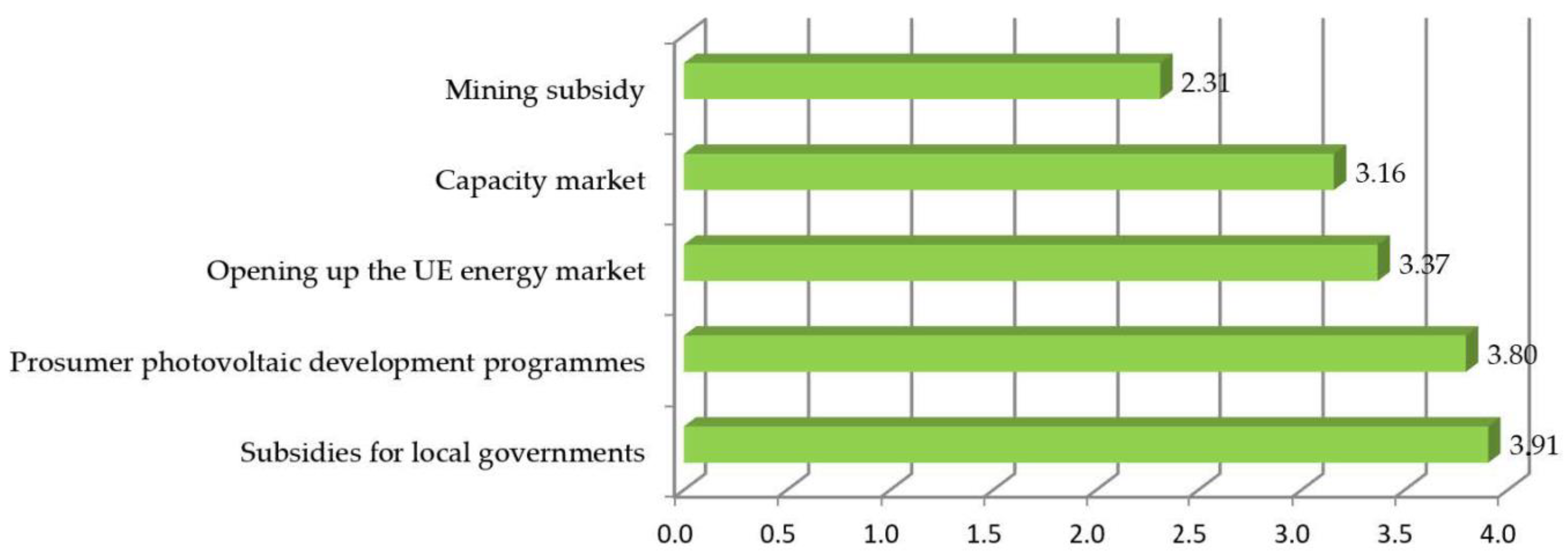
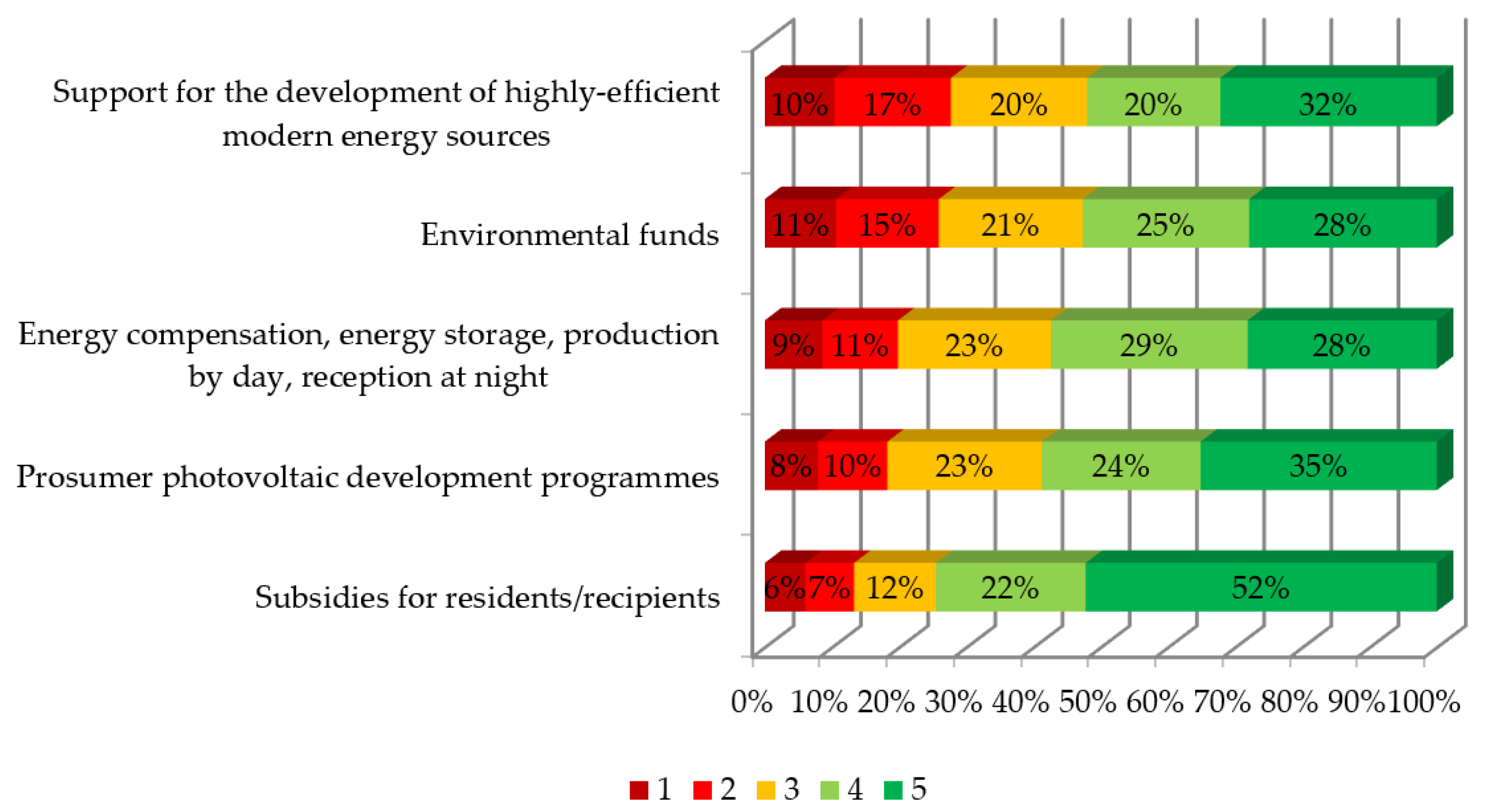
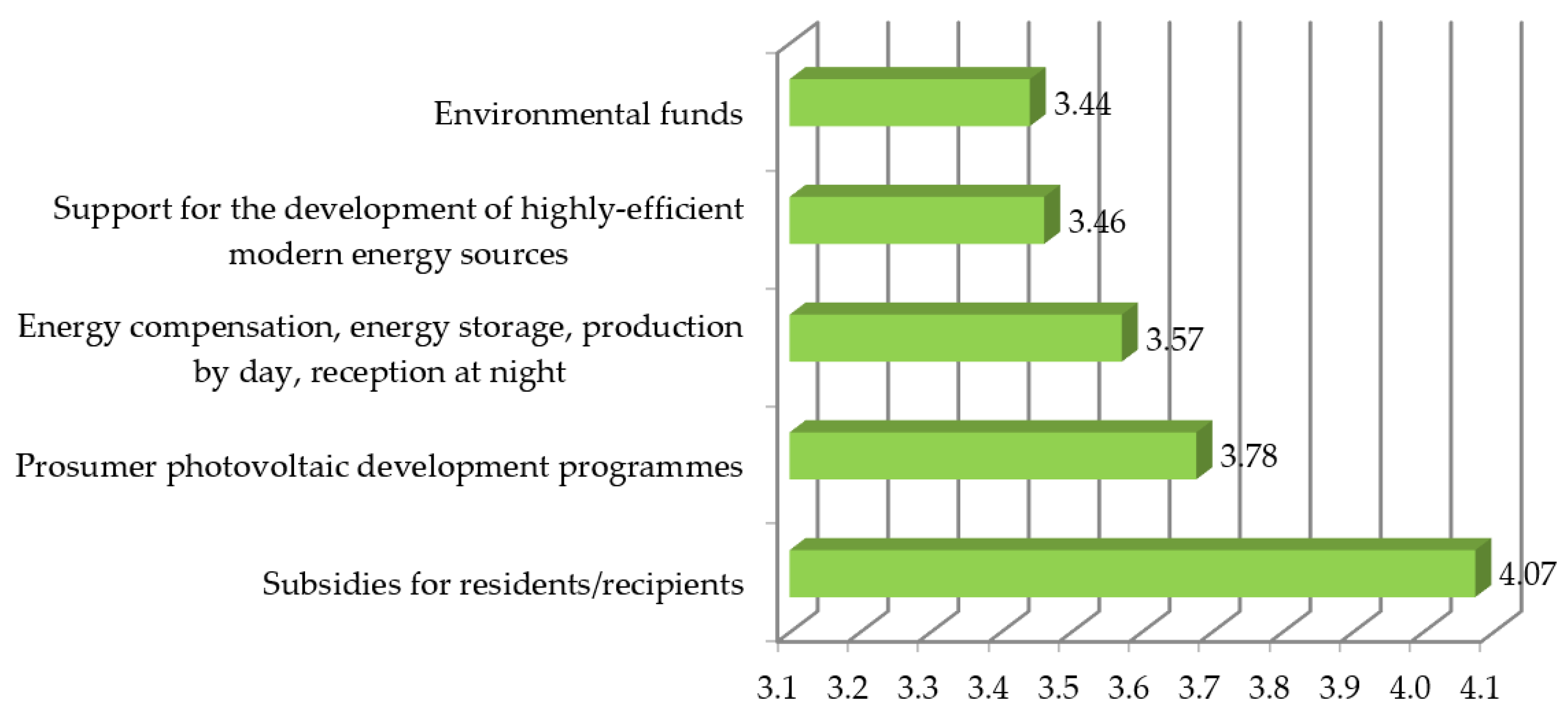
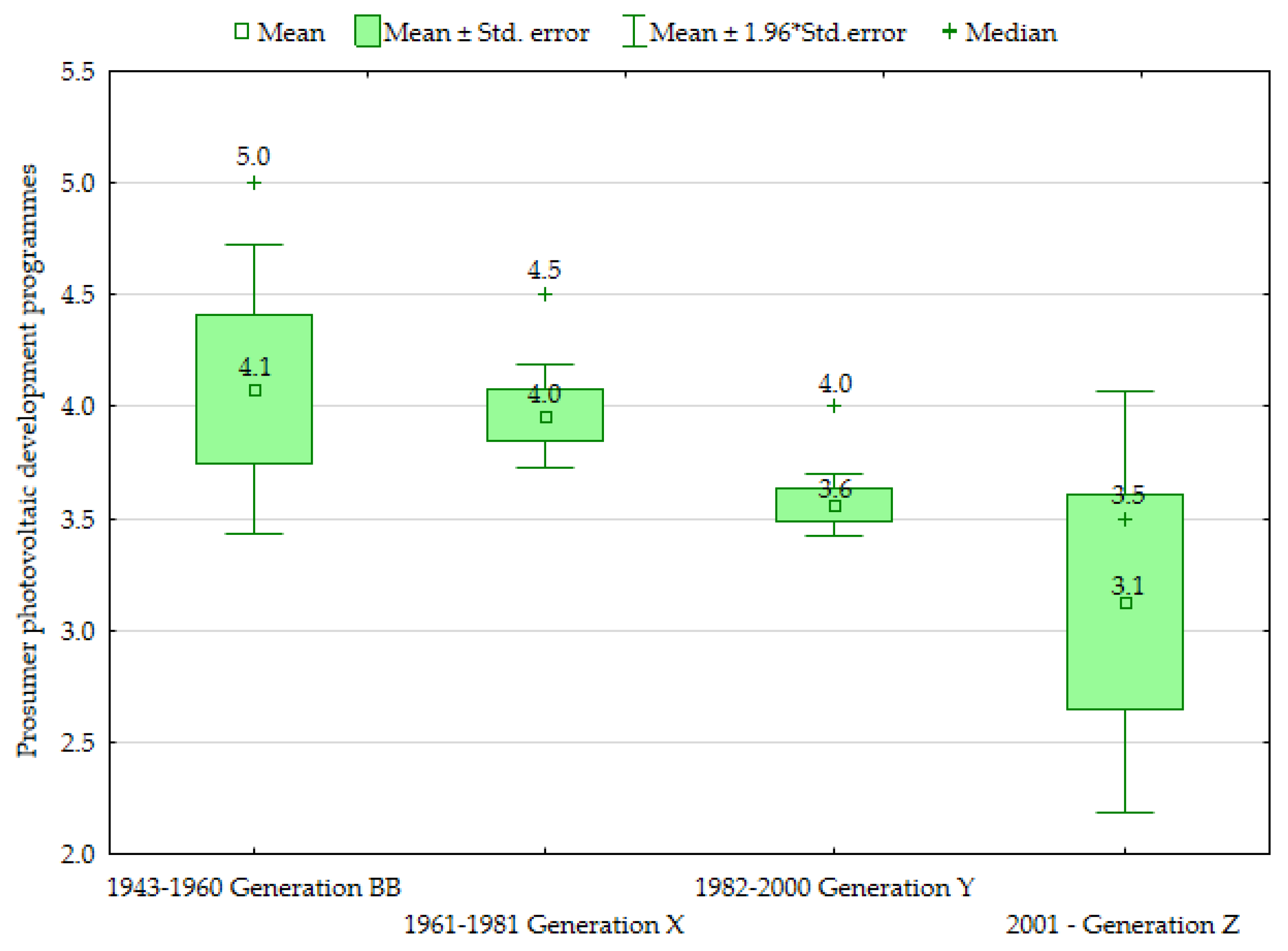
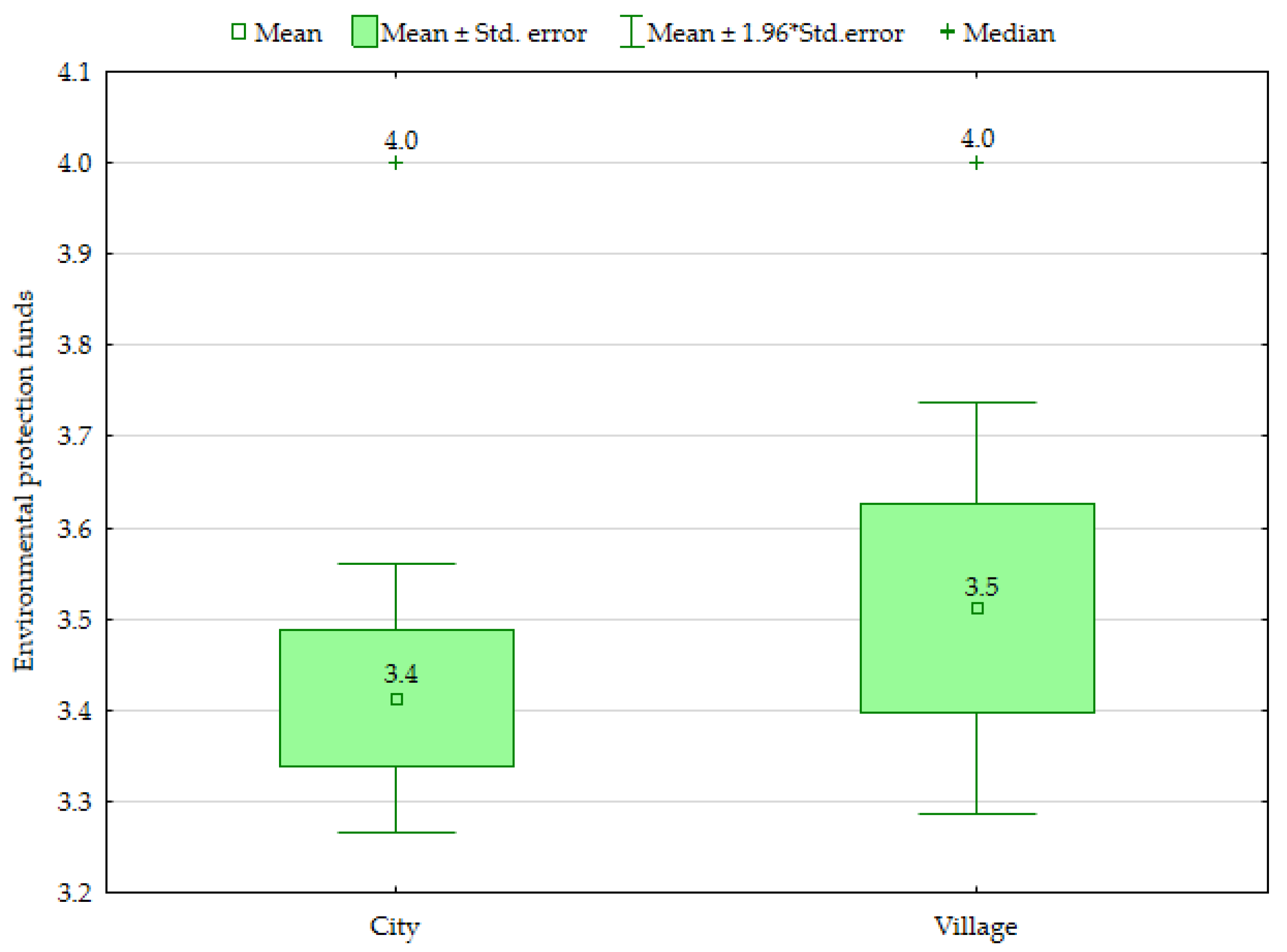

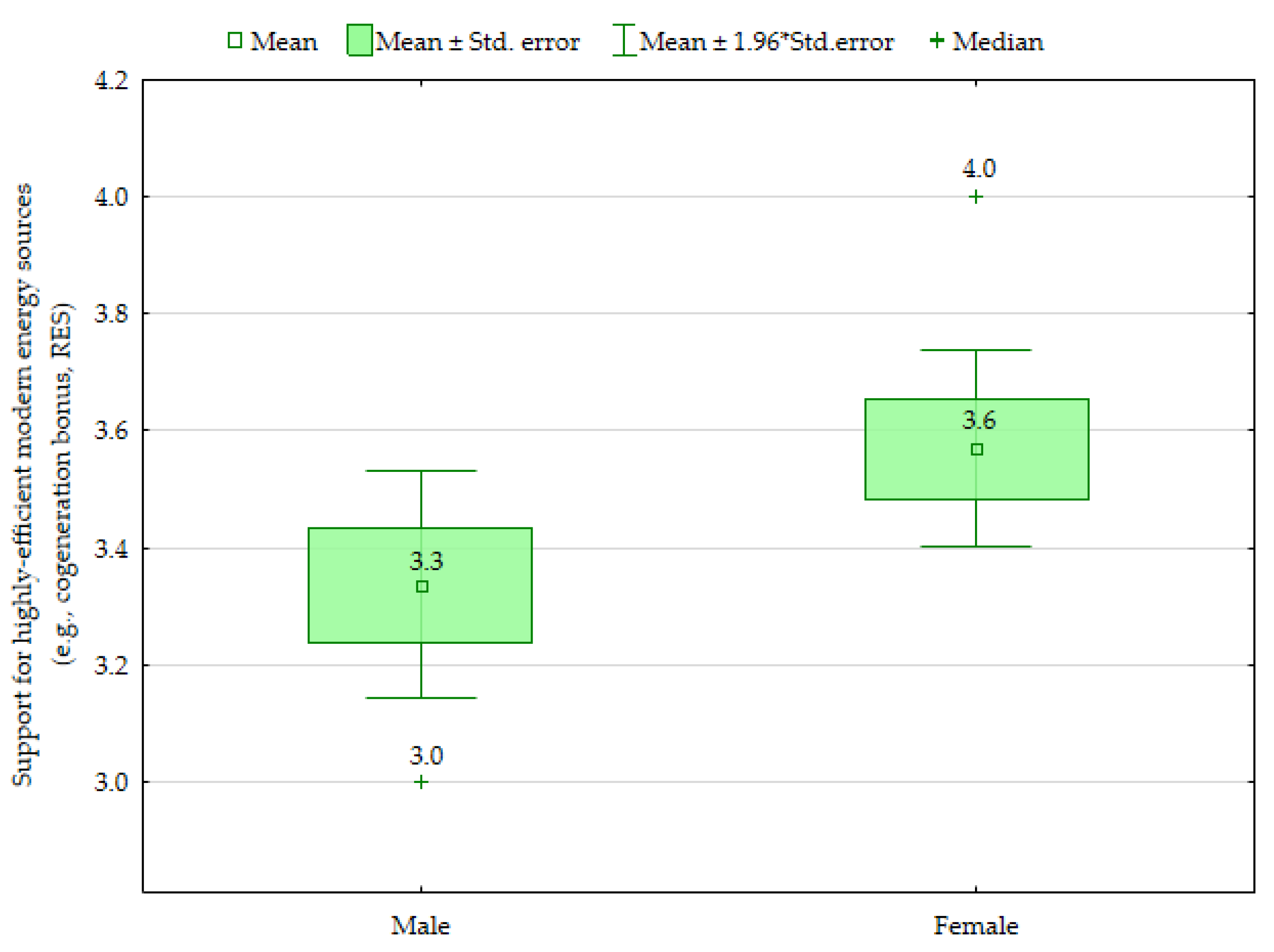
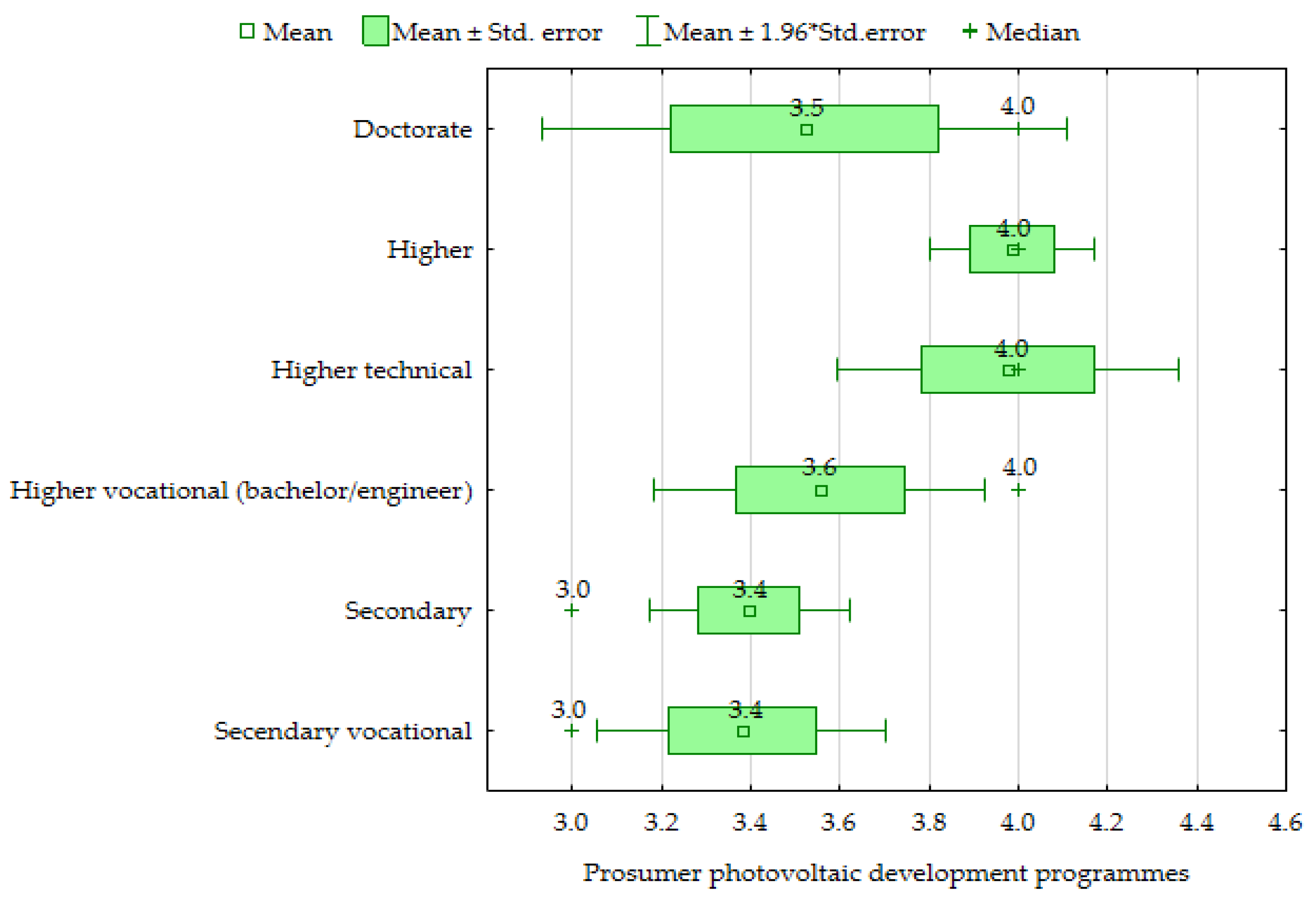
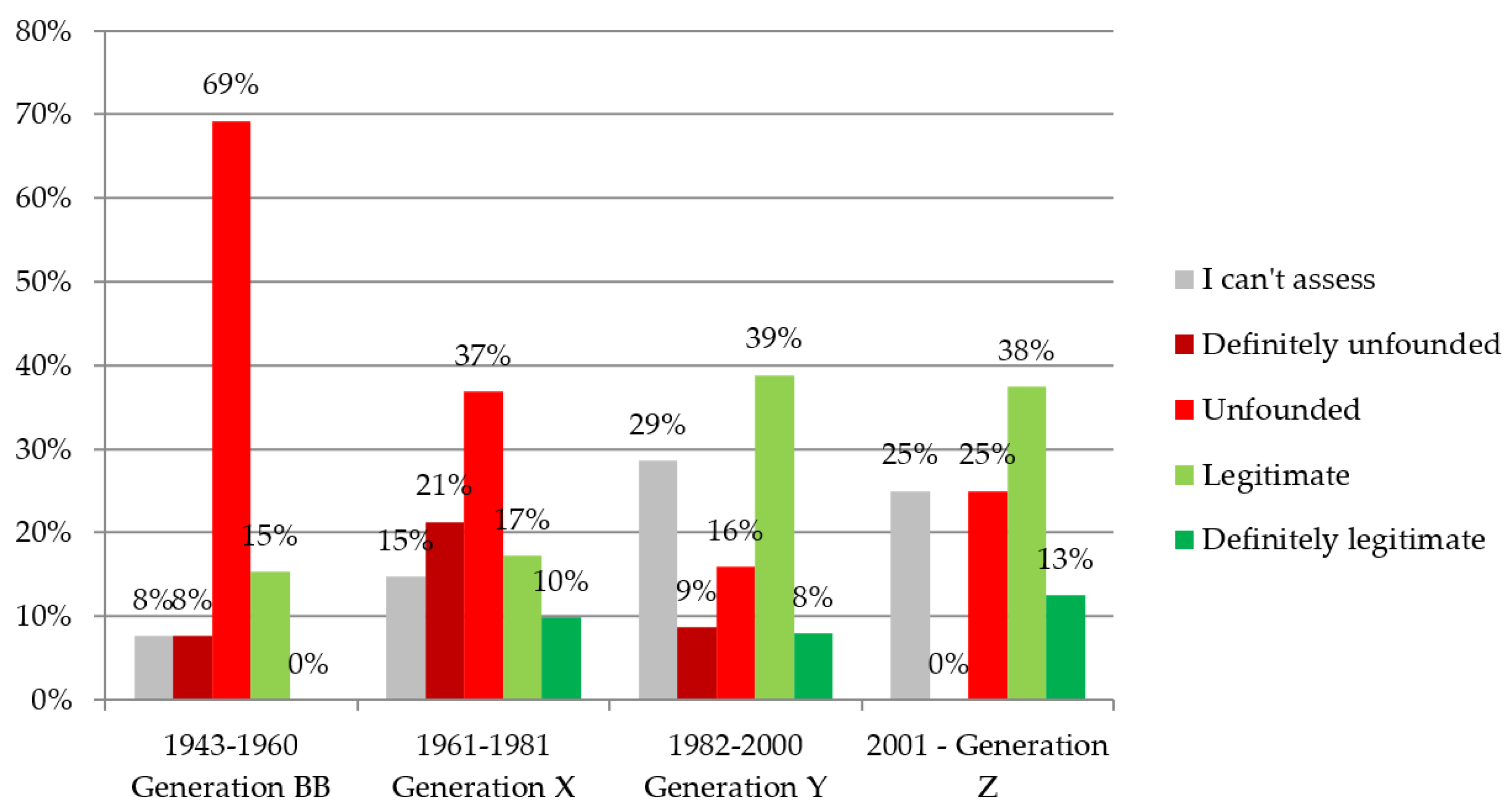
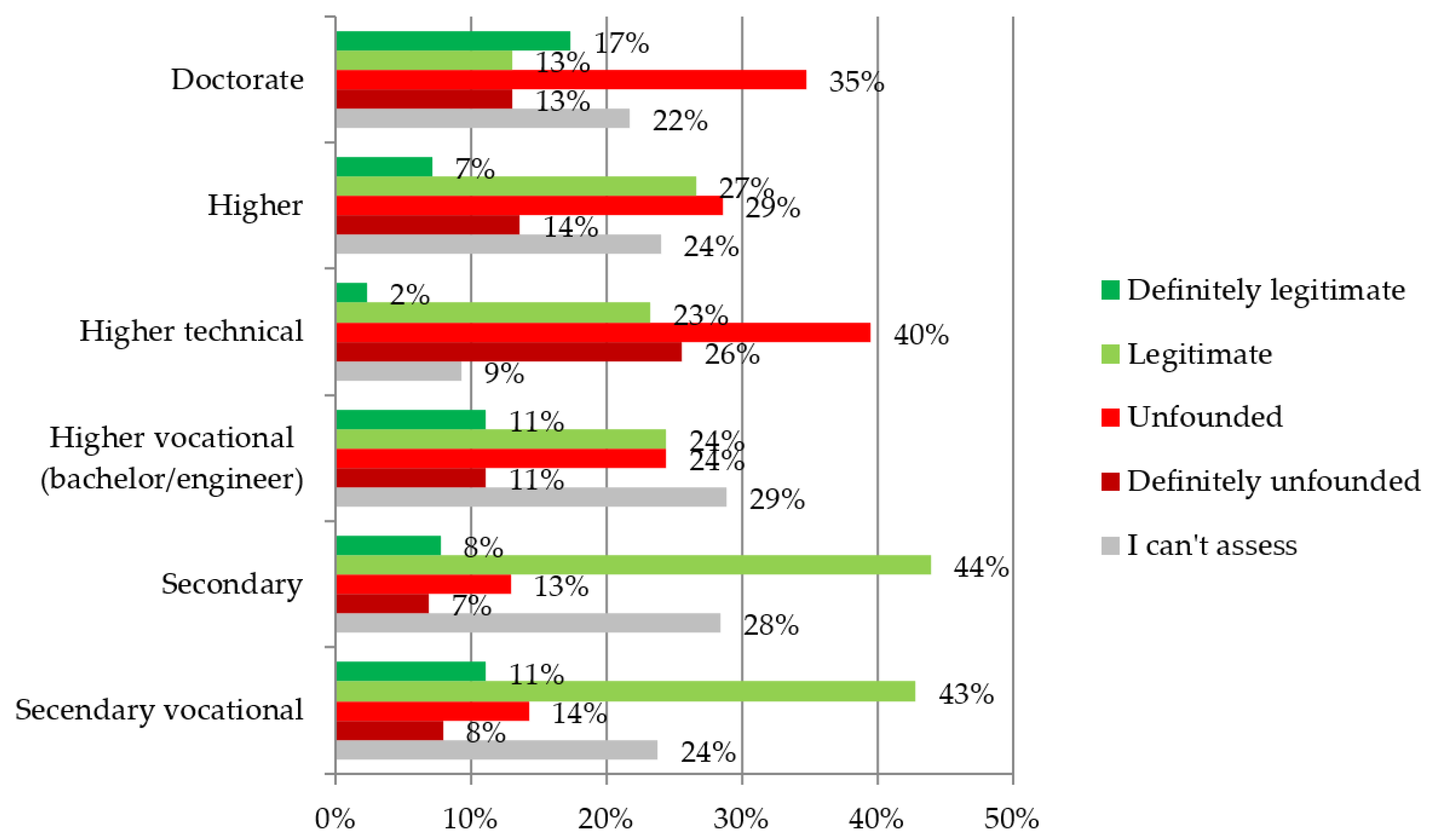
| Feature | N | % | Feature | N | % |
|---|---|---|---|---|---|
| Age | Range | ||||
| 1943–1960 (Baby Boomers (BB)) | 13 | 3% | Province | 259 | 58% |
| 1961–1981 (Generation X) | 122 | 27% | entire Poland | 96 | 22% |
| 1982–2000 (Generation Y) | 301 | 68% | European Union | 29 | 7% |
| since 2001 (Generation Z) | 8 | 2% | Worldwide | 60 | 14% |
| Place of residence | Gender | ||||
| city | 317 | 71% | Male | 205 | 46% |
| village | 127 | 29% | Female | 239 | 54% |
| Education | Position | ||||
| doctorate | 23 | 5% | director, member of the Management Board | 39 | 9% |
| higher | 154 | 35% | specialist (junior/senior) | 173 | 39% |
| higher technical | 43 | 10% | manager (coordinator/manager) | 60 | 14% |
| higher vocational (bachelor/engineer) | 45 | 10% | non-working person | 79 | 18% |
| secondary | 116 | 26% | apprentice/trainee | 52 | 12% |
| secondary vocational | 63 | 14% | owner/co-owner | 41 | 9% |
| 1 | 2 | 3 | 4 | 5 | ||
|---|---|---|---|---|---|---|
| Mining subsidy | 186 | 78 | 83 | 50 | 47 | (2.31 ± 1.38) |
| Subsidies for local governments (e.g., for the liquidation of furnaces) | 14 | 40 | 96 | 118 | 176 | (3.91 ± 1.12) |
| Prosumer photovoltaic development programmes | 14 | 46 | 101 | 138 | 145 | (3.80 ± 1.10) |
| Capacity market | 33 | 92 | 143 | 124 | 52 | (3.16 ± 1.11) |
| Opening up the EU energy market | 39 | 58 | 134 | 126 | 87 | (3.37 ± 1.19) |
| Age | Place of Residence | Gender | Education | Position | Range | |
|---|---|---|---|---|---|---|
| p | ||||||
| Mining subsidy | 0.0406 | 0.1035 | 0.0000 | 0.0057 | 0.0002 | 0.0047 |
| Subsidies for local governments (e.g., for the liquidation of furnaces) | 0.2866 | 0.3764 | 0.0004 | 0.7446 | 0.3236 | 0.5246 |
| Prosumer photovoltaics development programmes | 0.2940 | 0.9284 | 0.9142 | 0.0707 | 0.0676 | 0.5745 |
| Capacity market | 0.2977 | 0.7126 | 0.4198 | 0.6038 | 0.1547 | 0.3263 |
| Opening up the EU energy market | 0.3658 | 0.3820 | 0.6852 | 0.7827 | 0.6763 | 0.5331 |
| 1 | 2 | 3 | 4 | 5 | ||
|---|---|---|---|---|---|---|
| Subsidies for residents/recipients (e.g., for the decommissioning of furnaces) | 27 | 32 | 54 | 99 | 232 | (4.07 ± 1.22) |
| Prosumer photovoltaic development programmes | 35 | 46 | 102 | 105 | 156 | (3.78 ± 1.27) |
| Energy compensation, energy storage, production by day, reception at night | 38 | 50 | 101 | 130 | 125 | (3.57 ± 1.25) |
| Support for the development of highly-efficient modern energy sources (e.g., cogeneration bonus, RES) | 46 | 77 | 90 | 88 | 143 | (3.46 ± 1.37) |
| Environmental funds | 47 | 68 | 95 | 110 | 124 | (3.44 ± 1.32) |
| Age | Place of Residence | Gender | Education | Position | Range | |
|---|---|---|---|---|---|---|
| p | ||||||
| Grants to residents/recipients (e.g., for the decommissioning of furnaces) | 0.0504 | 0.0790 | 0.1380 | 0.0402 | 0.1380 | 0.6751 |
| Prosumer photovoltaic development programmes | 0.0025 | 0.1406 | 0.6599 | 0.0002 | 0.1096 | 0.3373 |
| Energy compensations, energy storage, production by day, reception at night | 0.3803 | 0.0538 | 0.0044 | 0.5841 | 0.2481 | 0.2112 |
| Support for the development of highly-efficient modern energy sources (e.g., bonus cogeneration, RES) | 0.0674 | 0.4993 | 0.0270 | 0.7434 | 0.7691 | 0.0640 |
| Environmental funds | 0.4684 | 0.0408 | 0.0894 | 0.6243 | 0.8393 | 0.1474 |
| p | |
|---|---|
| Age | 0.0000 |
| Education | 0.0002 |
Publisher’s Note: MDPI stays neutral with regard to jurisdictional claims in published maps and institutional affiliations. |
© 2022 by the authors. Licensee MDPI, Basel, Switzerland. This article is an open access article distributed under the terms and conditions of the Creative Commons Attribution (CC BY) license (https://creativecommons.org/licenses/by/4.0/).
Share and Cite
Czarnecka, M.; Chudy–Laskowska, K.; Kinelski, G.; Lew, G.; Sadowska, B.; Wójcik-Jurkiewicz, M.; Budka, B. Grants and Funding for the Processes of Decarbonization in the Scope of Sustainability Development—The Case from Poland. Energies 2022, 15, 7481. https://doi.org/10.3390/en15207481
Czarnecka M, Chudy–Laskowska K, Kinelski G, Lew G, Sadowska B, Wójcik-Jurkiewicz M, Budka B. Grants and Funding for the Processes of Decarbonization in the Scope of Sustainability Development—The Case from Poland. Energies. 2022; 15(20):7481. https://doi.org/10.3390/en15207481
Chicago/Turabian StyleCzarnecka, Marzena, Katarzyna Chudy–Laskowska, Grzegorz Kinelski, Grzegorz Lew, Beata Sadowska, Magdalena Wójcik-Jurkiewicz, and Borys Budka. 2022. "Grants and Funding for the Processes of Decarbonization in the Scope of Sustainability Development—The Case from Poland" Energies 15, no. 20: 7481. https://doi.org/10.3390/en15207481
APA StyleCzarnecka, M., Chudy–Laskowska, K., Kinelski, G., Lew, G., Sadowska, B., Wójcik-Jurkiewicz, M., & Budka, B. (2022). Grants and Funding for the Processes of Decarbonization in the Scope of Sustainability Development—The Case from Poland. Energies, 15(20), 7481. https://doi.org/10.3390/en15207481










